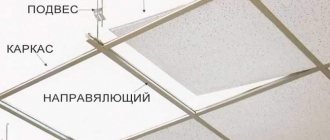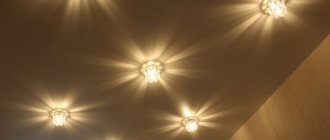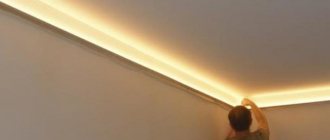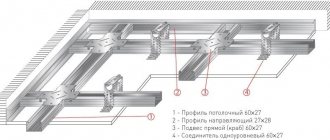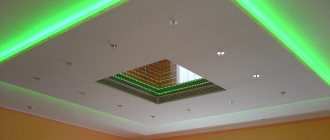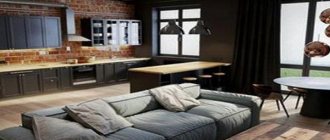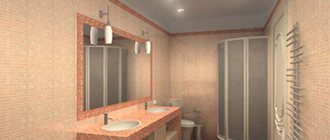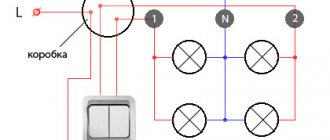Ventilation
When making a ceiling, you need to first think about the ventilation system.
At the stage when you need to cover the cellar, it is important to arrange openings for the passage of pipes
The conditions for stored products and the safety of the room itself depend on the quality of air exchange. It is not recommended to build a cellar without ventilation, as this will quickly spoil the supplies and the building materials themselves.
It is better to make a supply and exhaust circuit, which is made from asbestos-cement pipes. One of them serves as an exhaust hood, and the second as an influx of fresh air. pipes are placed in different corners of the room diagonally, which will allow air to pass through the entire room before being removed. This scheme will prevent stagnation of air masses in the storage facility.
The inlet is placed 20 cm away from the floor, and the hood is mounted right up to the ceiling, retreating 7 centimeters.
Pouring the ceiling
Before you start pouring concrete, you should assemble the formwork (from any material at hand), install the frame, and carry out reinforcement. To prepare the concrete mixture, you should prepare a special place for mixing or use special construction equipment, which will greatly simplify the task.
mix the concrete mixture for pouring; pour the mixture into the formwork; tamp the mixture, level it with a shovel or spatula; in case of large accumulations of air and the formation of bubbles, press down such areas with a shovel or spatula; remember that the mixture should not be very thick, otherwise the formation of bubbles cannot be avoided ;leave the concrete for several days until completely dry. The drying time is indicated in the purchase instructions; remove the formwork. Return to contents
Main features and directions of style
How to make a ceiling from MDF panels
Loft-style design is characterized not only by the general features of a large room, but also by a special color scheme, furniture arrangement, decoration features, and surface finishing methods.
To design an industrial interior for a city apartment, you need to rely on the following principles:
1. The layout should be open, without walls or separated rooms. This rule applies to the bedroom, living room and even the kitchen. Only the toilet and shower room can be closed.
2. Windows are not hidden behind curtains and curtains. They remain visible. Panoramic and dormer windows are held in high esteem.
3. The walls are not covered with wallpaper or covered with plastic. Most often they are bare brickwork or a concrete whitewashed surface. Sometimes the wall is covered with sheets of metal or plywood.
4. The floors in an authentic warehouse are usually concrete. But this option is not always acceptable for living space, so they are made of wood. Less often, self-leveling or from artificial stone and marble slabs.
5. The ceilings in the room should be high. Wires are run along them for lighting, and they are equipped with wooden load-bearing or false beams. Various communication pipes can run along the ceiling.
6. Lighting fixtures are hung in groups. They usually have a modern design.
7. Factory premises were initially very cold; it was customary to heat them with fireplaces, iron barrels with firewood, and open stoves. Therefore, these loft-style interior items are firmly entrenched in interior design.
8. The large height of the premises made it possible to equip the second level, for example, as a bedroom or study. It was possible to get to the second residential tier using an extension or stationary staircase. Today they are also used to equip rooms, made of metal and wood.
9. The color scheme of decoration and furniture is strict, consisting of two or three harmonizing or contrasting colors. The color scheme differs in different countries.
10. Furniture is selected either very modern and multifunctional, or frankly belonging to the last century (with peeling paint, frayed edges and missing details).
It is worth noting that different loft directions are characterized by special features.
Modern designers count only three:
- bohemian (boho-loft);
- glamorous;
- industrial.
Bohemian style - retains the spatial features of a large factory space, leaving the finishes untouched. However, the furnishings and accessories are selected with the imagination inherent in creative people. Furniture most often looks like it has been used, with traces of history on the sides. The decor may be completely incompatible with each other, but at the same time it is directly related to art. The interior is decorated with original paintings, or more often the works of unknown artists, sculptures, ikebana, art objects or musical instruments.
The glamorous direction is distinguished by a unique color palette. It is immediately recognizable by its combination of pastel colors. For example, it may not be the traditional white and gray color scheme, but gray and lilac
Particular attention is paid to the selection of chandeliers, shades and floor lamps. There are many of them, they have unusual silhouettes and serve as an accent of the interior.
Often next to a formal sleeping area there is a dining table surrounded by curved baroque chairs.
Industrial (industrial) direction is the most popular. To realize it, you need to fill the interior of a living space with signs of a factory building or production workshop. Structures made of pipes with valves, wooden trusses, chains and wire assemblies are held in high esteem. Furniture is used without frills, with regular geometric shapes.
Technology for creating a concrete ceiling
Required Tools
How to make a two-level plasterboard ceiling
For construction you will need a number of tools and tools:
- wooden slats for constructing formwork (4 pieces are enough);
- plywood sheet;
- wooden blocks designed to support the ceiling surface;
- nails;
- fittings made of metal;
- screws securing the formwork;
- concrete;
- a level that checks the horizontality of structures;
- equipment for pouring concrete;
- Master OK;
- basins or buckets in which concrete can be diluted;
- vibrator.
Construction of formwork
Construction formwork is made of wood
The construction of formwork requires certain skills in working with wood. You should think through all the subtleties and nuances of the construction of this ceiling element at the stage of planning and designing the house. The process should be approached seriously and responsibly, because the reliability and durability of the entire building subsequently depends on the strength of the formwork construction. It is advisable to consult in advance with an experienced specialist, who can also tell you where to apply for building permits.
The ideal option is to use pressure-treated wood; such material is guaranteed to withstand the load of the weight of concrete and reinforcement.
The entire structure is mounted on 4 wooden boards, the second row consists of plywood sheets or the same boards. As a rule, if the budget of the future owner of the building is limited, wooden slats are used, but the option with plywood provides a leveled ceiling that is easy for subsequent finishing.
Make sure that the boards do not have any curvature when laying them, avoiding gaps through which the concrete mixture passes. A building level will help confirm or refute the horizontality of the structure. The larger the flooring, the less likely it is that the ceiling will bend.
Metal fittings should be properly adjusted, focusing on the height of the room. Develop a sketch of the room, drawn in the smallest detail, first of all describing the formwork of the concrete surface.
The supports and ceilings are fixed with 2*4 beams and nails. How correct the plumb line of the supports is is also checked with a horizontal level.
Strengthening the building structure
To make a concrete ceiling, you need to properly fix the reinforcement in the required area, which needs to be purchased in large quantities; the master will tell you in what quantity. What is the fittings used for? The concrete ceiling is supported only by walls and pillars; otherwise, metal products act as supports.
Reinforcement for concrete mix
If wood is used to create formwork, the surface is covered with polyethylene, which will prevent the mortar from penetrating inside. In the upper, one-third part of the wall, iron pins should be driven in, going all the way to the ceiling. Long slats are located from one wall to the opposite, medium-sized pieces are placed perpendicularly - this is how cells measuring 10 * 10 cm are formed. The reinforcement rods are secured using knitting wire.
When forming a support, pay attention to the fact that all sides of the frame extend onto the load-bearing walls from 10 cm or more
Pouring the surface with concrete
Pouring a monolithic ceiling slab
Now you can start pouring the ceiling with concrete. Here you cannot do without special equipment - a concrete pump equipped with a number of hoses and a pump that pour concrete into the erected formwork. If you do not have the necessary equipment, the mixture is raised to a height using a crane.
It is important to choose the right brand of concrete mass, in sufficient volume for construction work. More often, concrete marked B250 is ordered for ceilings.
Pouring concrete is carried out in several layers; no more than 12 hours should pass between the application of the previous and subsequent ones, otherwise the poured layer will dry completely, which is unacceptable in accordance with generally accepted technology.
The large perimeter of the ceiling is processed from the far corner, and the material that completely covers the formwork is leveled on all sides. Be sure to check the vibrator for air pockets forming in the mixture. After completion of the work, it is also necessary to additionally fill the screed, which ensures a perfectly flat plane.
Now we just have to wait up to 2 months, during which time the mass will finally harden and the formwork can be removed and the construction of walls and other parts of the building can continue. If it is too hot outside, it is advisable to spray the concrete with water 3-4 times a day during the drying process, otherwise the material will crack. There is no need to rush to get rid of the formwork - the ceiling may bend.
Concrete ceiling finishing
Often, during the finishing work, many questions arise, the most popular of which is: how to level a concrete ceiling quickly, easily and inexpensively. This can be done in several ways - namely, sheathing it with plasterboard or puttingty. The first option is simpler and faster to implement.
Plasterboard ceiling
And as always, there will be a “but” that will ruin everything. In our case, the cost and quality of gypsum boards. Really good drywall is expensive, which is unjustified if you are going to make suspended or suspended ceilings in the future.
Shown how to putty a concrete ceiling
Do-it-yourself putty is cheaper, but also requires more labor. If you have never done such work, then it is best to watch a video that will tell you in detail how to putty a concrete ceiling. You may not become a professional finisher, but you will be able to supervise the workers.
After leveling the ceiling, you can leave everything as is or move on. Today, the most popular finishing method is suspended ceilings. Due to the fact that demand is high and the level of competition is incredibly high, prices for them have dropped significantly. In this case, the concrete ceiling does not need to be specially prepared.
Creative ideas
For those who want something “like not everyone else”, we offer a traditional and more creative option - coloring. No, you don’t need to paint a solid canvas with regular water-based paint. Today there are many different shades of pigments. And creative individuals can combine them in some unusual ensemble of drawings. We offer a small selection of options for painting concrete ceilings.
The easiest way is stencil painting. All that remains is to choose the colors and the required stencil. And the rest is a matter of technology.
As you can see, pouring concrete on the ceiling is not only reliable and durable, but also beautiful. You can create anything you want on such a canvas, the main thing is desire and imagination.How and with what to glue wallpaper?
Which ceiling is better to make in the kitchen?
It is important that the base surface is stable. Otherwise, it needs putty and primer.
The second point is the choice of glue. Each type of wallpaper has its own glue. Nothing complicated: all manufacturers indicate on the packaging what wallpaper this or that adhesive is intended for.
The glue is applied with a paint brush or roller. In the latter case, you will need a tray where you will need to drain the remaining glue by squeezing the roller.
Of course, it is enough to apply glue to the ceiling foundation. However, in the case of glass wallpaper, vinyl and non-woven wallpaper, it is advisable to apply it also to the underside of the canvases. The air temperature in the room should be positive, without drafts.
Air bubbles under the wallpaper and excess glue must be carefully removed.
Prefabricated floors made of reinforced concrete panels
Most often they are made from round-hollow panels, which are distinguished by an affordable price, lighter weight, and increased thermal insulation properties compared to monolithic ones. Floors made from them can be quickly installed, and a wide range of standard sizes allows you to select a slab to suit the customer’s needs. The only drawback is the mandatory use of a crane.
The length of the produced slabs is from 1.8 to 15 meters, width – from 0.6 to 2.4 m.
The standard thickness of factory-made PCs is 220 mm, and the calculated load-bearing capacity (from 350 to 800 kgf/m2) of the panels differs due to the use of different grades of concrete and reinforcement. The weight of the slabs depends on the size and ranges from 0.65 to 2.5 tons.
Marking allows you to determine the necessary parameters. The letters indicate the product type PC (floor panel), PNO (lightweight decking panel), the numbers indicate the length and width in decimeters, as well as the load in kilopascals. By removing the dead weight of the slab from the design load, the permissible payload is obtained. When laying parts on the wall, the support depth must be maintained at least 12 cm.
If the length of the room to be covered exceeds 9 meters, a monolithic ribbed slab is suitable. It is half the weight (the weight of a square meter is about 270 kg), which reduces the total load on the walls by almost a quarter.
Sometimes cracks occur in floor slabs. They can be shrinkage or deformation. Cracks up to 0.3 mm are not dangerous, but if the panel has large diagonal or longitudinal cracks, it is better to replace it. If cracks appear during operation, then it is necessary to strengthen the slab by adding an additional reinforced layer of screed on top.
To insulate the ends of the panels in the outer wall, which serve as “cold bridges,” lightweight concrete thermal liners are used.
Practice shows that sometimes the dimensions of the room turn out to be disproportionate to the width of the panels and it becomes necessary to additionally fill the monolithic areas between the slabs. If the movement of the slabs is up to 5 cm, such seams are filled with concrete without reinforcement; seams above this size require the installation of an additional reinforced frame.
Before laying the floor on the load-bearing walls, be sure to install a reinforced monolithic belt under the slabs. This is a continuous closed beam, the reinforcement of which is carried out with high-quality rolled metal.
To guarantee the purchase of high-quality reinforced concrete PCs, it is better to buy them directly from reinforced concrete factories or from construction companies that have the capacity to produce reinforced concrete products. The average price of one square meter of a hollow-core floor panel in Moscow and the region ranges from 1,100 to 1,200 rubles. The most popular slabs are from 3 to 7 meters, while products of shorter and longer lengths will cost more (in terms of m2). The most popular width is 1.2 – 1.5 m. Not all manufacturers produce slabs up to 1 meter and 1.8 meters wide, which also affects their price.
Prefabricated monolithic
The installation of prefabricated monolithic floors has not yet become the most popular method, but has already won its niche in the construction market. The essence of the method: reinforced concrete beams are laid on the walls (step - 60 cm) and hollow blocks between them, the entire structure is monolied. Installation is possible without the use of mechanisms, since the weight of a linear meter of the beam is 19 kg. Due to the large-hollow blocks, it is lightweight and has increased thermal insulation qualities. The only negative is the labor intensity (the blocks are laid manually). Before pouring concrete, the structure should be reinforced (wire mesh with 10x10 cm cells), the minimum thickness of the concrete layer is at least 5 cm.
One square meter of finished floor weighs up to 390 kg (if the blocks are made of expanded clay concrete) and up to 300 kg (if the blocks are made of polystyrene concrete). And this is almost two times less than a monolithic floor 2 cm thick (about 500 kg/m2).
GSK Columbus (MARCO) offers an average of 1,100 rubles per square meter of structures that make up prefabricated monolithic floor slabs, and turnkey installation work will cost 3,000 - 3,500 rubles per m2.
Leveling the surface
After leveling the ceiling, you should get a flat surface without voids or differences.
After the concrete surface has hardened, it should be leveled. In order not to damage the ceiling, not to create cracks and splits, carefully select materials for such a process. For heights from 2 to 5 cm, Rotband plaster is used, for heights less than 2 cm - Fugenfuller Knauf. Don't forget to reinforce the formwork and ceiling. A suitable material for reinforcement would be metal mesh.
Fugenfuller Knauf putty is sold in dry form (mixture):
dilute the plaster with cold water; maintain the proportions of 2 kg of mixture per 2 liters of water; stir the solution until smooth; the solution remains functional for 30 minutes. You need to work quickly, confidently and efficiently; application is carried out in two layers. The first ball should be the largest and densest; apply a second layer, thinner than the previous one. The second layer should be applied 5-10 minutes after drying the first; direct the movements of the spatula towards you, leveling the surface of the ceiling, compacting the solution; level the coating using zigzag movements; leave the applied layers for several days to allow them to dry. The required time must be recorded in the instructions for the individual type of substance used; the minimum drying time is 1 day. Maximum - 7 days.
Tip: Do not try to speed up the process by drying the surface. If you influence the ceiling in this way, it will begin to crack, crumble, and may collapse.
After drying the surface, remove any unevenness or roughness with sandpaper. The depressions are puttied. Before applying putty, sand the surface. Remove dust with a vacuum cleaner, damp brush or cloth. After you have leveled the ceiling, you can begin painting and further decorating it. The final result will pleasantly surprise you. The surface will have an aesthetic appearance.
Currently reading: Reinforced concrete block
You can create a concrete ceiling yourself, taking into account all the nuances and complexities of the process. If you do not have the necessary skills or do not want to waste your own time, seek help from a specialized construction team. For a set price (check the price list yourself), they will carry out the required scope of work (installation, leveling, decorating, finishing, pouring, sanding) efficiently and quickly.
Return to contents
Modular architectural concrete slabs
Until recently, concrete in the interior did not have too many supporters. Most often it is associated with a cold environment in which it is uncomfortable to live. Meanwhile, it is currently experiencing a renaissance. This material is very characteristic, easy to use, elegant and noble.
Modular concrete slabs can be used for finishing. They can have different sizes. Their cost depends on the size and type. Installing such slabs will be a challenge for the average person, but an experienced master will not have any problems. Any impregnation does not change color, but serves primarily for easy cleaning. In addition, impregnation reduces water absorption. Thanks to this, concrete slabs can be used even in conditions of high humidity, for example, in a bathroom. Concrete slabs can also be protected with a thin layer of clear resin.
Lightweight architectural concrete panels are used on the ceiling. Today, industrial style interiors are still associated with freedom, extravagance and urban artistry, making them ideal for an industrial style apartment.
Making formwork
By the way, this is a fundamental point in the work. According to its execution, the installation of the entire building is dependent and error-free.
Important: Before installing the formwork, you should make sure that it will support the full weight, including the reinforcement. To do this, it is better to consult a professional in this field.
Gain
This is the use of iron grating to fill the ceiling. This significantly increases the strength of the floor. It must be performed:
- When the thickness of the ceiling is less than 15 cm, then reinforcement can be carried out in 1 layer;
- Filling is done with liquid concrete so that its grade is no less than M200. Any other material will not provide the required reliability;
- When strengthening, it is necessary to lay reinforcement bars in the form of a cross. Connections must be welded. Specific requirements require strengthening areas of heavy load. These are: the middle of the panel, points in contact with the supports, places where there are holes;
- Reinforcement of the holes is created by a solid contour and additional reinforcement.
- To accomplish this, the opposite sides of the structure should be combined with each other. The step width is determined by the thickness of the reinforcement used, which the master will tell you. For the fidelity and rigidity of the fasteners, it is better to lay the 14th channel along the length. It is more rigid and will not allow the structure to sag;
- Then we lay down the transverse reinforcement. If you use 12-gauge reinforcement, then the step must be at least 200 mm. If you used fittings 10. Then the step must be at least 250 mm. In any case, there is no need to skimp on material;
Frame installation
Important: When laying reinforcement, it must be inserted into the brickwork no less than 15 cm. If you are making a home ceiling where there is already a roof, and not in a new building, then to install the reinforcement you need to make holes in the wall using a punch
- Connections with transverse ones are rewound with steel wire or welded. If you use wire, then before consumption you need to anneal it so that it is more flexible. To do this, you simply need to heat the material over a fire and let it cool in a natural environment. Do not under any circumstances use water for cooling, this will only harden the wire and not release it;
- Next, the part of the frame located below should be covered with formwork in the form of a shield. To do this, you need to use edged boards or moisture-resistant plywood;
- Next, we press the formwork from below with logs or telescopic racks;
Type of reinforced grating
Important: When installing logs, it is necessary to take into account the load on them. Place components perpendicular and rigid to the ground
When loaded, the rack can be pulled to the side and then the whole system collapses
After installing the frame, you need to check the horizontal presence of the surface. Be sure to do this.
Method for increasing frame rigidity
Pouring concrete
After the frame has been installed, you can order concrete or create it yourself. To do this, you need to prepare a place for unloading or install a kneading tub.
Pouring concrete using a pump
Important: Whatever pouring option you choose, it does not have to be stopped until the formwork is completely filled. You need to work instantly and together
- After mixing or delivering concrete, it must be poured into the formwork. Plus, after laying, you should walk along the pouring surface and push the coating with the handle of a shovel. With this effect you will remove any areas of air accumulation that may occur;
- If you use a pump when filling, be sure to use a shovel. When applying the solution, it may create air bubbles on the fittings. This cannot be allowed. Use a mixture that is not very rich;
- We wait for the concrete to dry completely and remove the formwork.
Pros and cons of concrete ceiling
As with any technology, it has its own positive and negative factors:
- In specifics, it is excellent to use it at the initial construction stage. It’s simply not comfortable to do this in a ready-made room.
- This design is more complex in contrast to floor panels. True and more reliable;
- More efficient sound and heat insulation;
- The cost of the project increases with the use of such technology;
- Installation takes longer than installing floor panels;
- You need to seek the help of professionals; you will need to calculate the load of the floor. The thickness of the concrete depends on this. The weight of the reinforcement that is used to strengthen the system should also be taken into account;
- A huge amount of waste during production.
If you choose this kind of ceiling, then you can figure out how to putty a concrete ceiling.
Required Tools
To paint and prepare the ceiling surface, you will need to purchase a number of tools, which you cannot do without during all the work.
Today there are many rollers of various sizes and materials. Foam rollers are least suitable for applying paint, since bubbles can form on the ceiling surface due to the porosity of the material. A rotating velor base allows you to use the mixture economically, but such rollers require ideal surface preparation.
The best option is a roller with a fur base, where the pile can be either medium or above average length. A roller with a short pile is not able to absorb the required amount of paint, so you will have to dip it in paint more often. Rollers with long piles have a different problem: they absorb too much emulsion. Because of this, smudges may form on the surface.
Rollers are used to paint a large surface area, and in order to paint hard-to-reach places (corners, seams, joints), it is better to use brushes of small width. As a rule, a pile base width of 4 cm is sufficient.
But it is worth remembering that a spray gun is more expensive than a regular roller. If painting the ceiling is not your main activity, then it is better to limit yourself to purchasing cheaper tools.
Using a brush or roller, it is impossible to do without a cuvette. It helps to save paint. This container consists of two compartments. The paint is poured into one, and the other with a grooved side allows it to be distributed over the entire surface of the roller base. The paint lies evenly on the ceiling surface without smudges, the excess mixture remains in the ditch.
An important device when painting a ceiling is a stepladder. The presence of a stepladder allows you to get closer to the ceiling surface at the most convenient distance. But do not forget that the stepladder will have to be moved from time to time. To make work easier, you can use a special roller with a telescopic handle.
To prepare the ceiling surface you will need plastic film. By covering all surfaces and furniture that cannot be removed with it, you can avoid paint splashes.
Other tools may also be required for preparatory work. Cleaning and further preparation is carried out using a spatula, sandpaper, bucket and foam sponge.
Necessary tools and materials for building a concrete ceiling
Wooden beams are needed to support the ceiling.
- 4 wooden boards for constructing formwork;
- plywood;
- wooden beams to support the ceiling;
- nails;
- metal fittings;
- screws that are necessary to secure the formwork;
- concrete;
- building level;
- hammer;
- concrete pouring machine;
- Master OK;
- containers for concrete;
- vibrator.
The process of pouring a ceiling with concrete consists of several stages.
Choosing a concrete grade
It should be said that the issue of selecting the grade of concrete for a homemade ceiling is extremely important. After all, the wrong choice of this material promises problems with strength, decreased resistance to loads, and so on. Therefore, the recommendations of specialists in this matter will definitely not be superfluous. Let's look at what types of concrete there are today.
- Grade M100 is the lowest quality solution and is usually used before pouring monolithic structures. Typically, this option is used for pouring a foundation strip, forming a concrete pad, installing a curb, and so on.
- Concrete grade M150 is used for floors, screeds, and also for creating foundations for buildings with a small number of floors.
- M200 will be used to form floors, blind areas and screeds. Due to the high strength of the material, it is used for the production of concrete stairs.
- M250 will be an excellent solution for creating a monolith of strip foundations, as well as floor slabs.
- M300 is used to form floor slabs, as well as concrete stairs.
- M350 is used to create various monolithic surfaces, beams and pools.
Brands M400, M450 and M500 are practically not used in the construction of private buildings. They are in demand in the creation of buildings such as dams, dams, bridges and various hydraulic structures.
What you need to know about concrete ceilings
Pouring the ceiling with concrete is meant as monolithing a roof or ceiling. This can also be understood as pouring already assembled floors from ready-made reinforced concrete products.
The latter is most often used when installing a roof for additional heat and sound insulation. The monolithic pouring method is more applicable in the initial stages of construction.
Let's consider the main comparative characteristics of such concrete ceilings:
However, such monolithic works can also be dangerous. If the formwork is placed incorrectly, you will end up with a low-quality concrete ceiling, which can lead to destruction in the future.
Therefore, do not take on board this problem yourself. Be sure to consult with specialists, study all the necessary technical documentation, and it is advisable to attract an “experienced” master to your team who will lead the entire “parade”.
With all this, there is nothing “outlandish” about the monolithic filling of the ceiling. All operations are available and can be performed independently.
Preparatory work
At the preparatory stage, the required material is calculated, and supports for the formwork are installed. The supports are placed so that they can support the weight of the entire structure before it hardens. Typically, wooden or metal beams are used for this.
Installation of formwork
After installing the supports, they begin to install the formwork. They are made from timber of standard sizes, 15 by 15 cm. They should rest with their ends on the walls of the room. On the underside of the beams, sheets of moisture-resistant plywood are attached to them, the thickness of which should be at least 1.5-2 cm.
Reinforcement
Reinforcement is one of the most important stages in the installation of ceilings. It determines how much pressure the entire structure can withstand.
Reinforcement is one of the main stages of construction
To reinforce the concrete ceiling in the basement, both a special mesh and simply construction rods are used
It is important to position them correctly - at a distance of 20 to 25 cm from each other. In this case, the edges of the reinforcement should protrude several centimeters from the concrete slab
The reinforcement or mesh is connected to each other using wire.
How to fill a cellar ceiling
To fill the ceiling, concrete grades no lower than M200 are used. Only such concrete mixtures can be considered sufficient in terms of their strength characteristics for ceiling structures.
It is necessary to start pouring the finished concrete mixture from one of the corners, but do it in different directions, simultaneously compacting it. If possible, you need to fill the entire space at once, but if there is no money for this, then you can fill it in several passes.
After pouring is completed, you need to immediately level the concrete, for which you use shovels and a building level. The builder has no more than half an hour for this procedure before the mixture sets.
Stage 1. Construction of formwork
The first row of concrete ceiling formwork is constructed from 4x4 boards.
To get a good concrete ceiling, you need to make the formwork correctly. Its construction is a very complex process. When starting work, you need to have at least some experience in working with wood.
All information about formwork and its strengthening must be provided in the house construction plan. The durability of the constructed building will depend on the concrete ceiling you erect, so before starting work, you need to consult a competent specialist. In addition, you need to strictly follow all the rules and obtain all construction permits so as not to expose yourself to unnecessary threats.
It is best to use pressure-treated wood when constructing formwork. It is necessary to make sure in advance that it will withstand the concrete and the weight of the reinforcement.
The first row of formwork is built from 4x4 boards. Next, 2x4 sheets of plywood or wooden boards are installed on this structure. If the construction budget is limited, then wooden boards can be used. The option with sheets of plywood will be much better, since thanks to this the lower part of the ceiling will be perfectly straight and no additional device will be required to keep it level.
When using wooden boards, you need to double-check that they are straight and in excellent condition. In addition, it is necessary to ensure that there are no gaps between the boards, because this may cause concrete leakage. When constructing formwork, it is necessary to use a building level to ensure that the structure is horizontal. If this is not done, correcting errors will require a large investment of money and time.
The spirit level checks the support or the correct plumb level.
Old boards are also suitable for making formwork. Supports prevent the deck from sagging under the heavy weight of the concrete mixture. Supports are installed very often.
To get a better idea of the procedure, you can view the ceiling from inside the house. The metal fittings used must be adjustable so that they can support a lot of weight and be well adjusted to the height of the room.
Before starting work, the architect prepares a sketch from which you can see in detail what the structure of the concrete ceiling formwork is.
In order to check whether the level and shape of the supports are plumb correctly, it is necessary to use a spirit level. Often, when building a concrete ceiling, there is a need to build a strong reinforcement. Otherwise, the system will not be stable and the walls will not be able to support their weight.
When using 4x4 flooring, it must be carefully secured to the base of the ceiling. For this purpose, 2x4 beams and nails are used for strong fixation. The correct plumb line of the supports must be checked with a building level.
